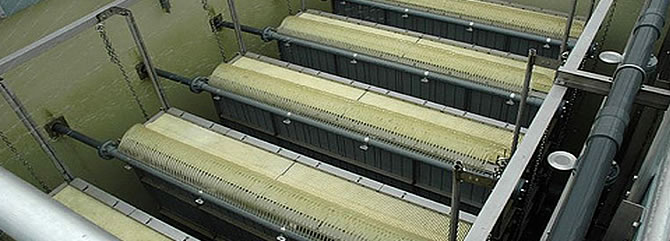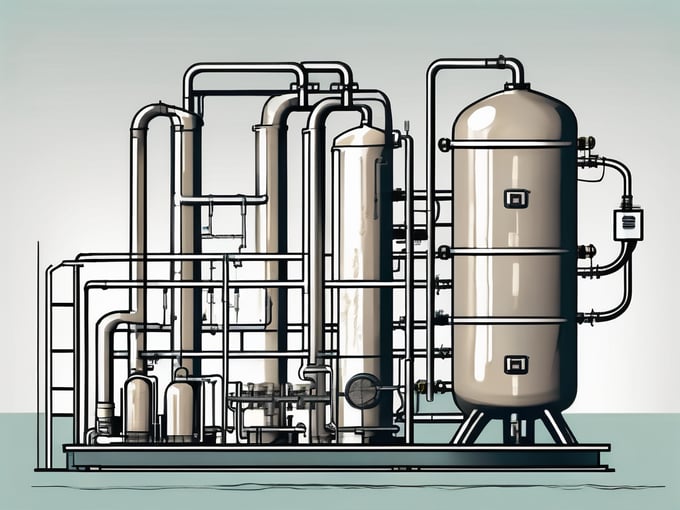How Membrane Bioreactor Can Help Meet Stringent Environmental Regulations
How Membrane Bioreactor Can Help Meet Stringent Environmental Regulations
Blog Article
Comprehending Membrane Bioreactors: The Future of Wastewater Treatment
Membrane bioreactors (MBRs) represent a notable advancement in the area of wastewater therapy, incorporating biological processes with sophisticated membrane filtration to enhance effluent high quality. As worldwide water scarcity and strict regulatory frameworks become increasingly pushing concerns, MBR modern technology uses an efficient action with its ability to reduce footprint and maximize source healing. The adoption of MBRs is not without its obstacles, which warrant cautious consideration. What are the crucial factors affecting their application and long-term stability in numerous contexts? The responses may improve our method to wastewater management.
What Are Membrane Bioreactors?

The core parts of MBR systems consist of a bioreactor where microbial activity occurs and a membrane layer device that filters the mixed alcohol. This twin performance allows the synchronised deterioration of raw material and solid-liquid separation in a single step. MBRs can operate in both immersed and exterior configurations, with immersed systems being a lot more typical due to their portable design and functional effectiveness.
The adoption of MBR modern technology has gained grip in various applications, varying from community wastewater therapy to commercial effluent management. MBRs are especially advantageous in circumstances where space is minimal or strict effluent quality requirements must be satisfied. By keeping a high concentration of microbes within the bioreactor, MBRs enhance the destruction of organic contaminants, therefore yielding greater therapy effectiveness contrasted to traditional techniques.
Secret Benefits of MBR Innovation
The combination of biological treatment with membrane filtration in MBR systems provides various advantages that set it aside from standard wastewater treatment techniques. Among the key advantages is the improved effluent high quality. MBRs efficiently remove suspended virus and solids, attaining greater levels of purification that fulfill rigorous discharge requirements and assist in water reuse applications.

Another considerable benefit is the lowered sludge production. MBR systems generate less excess sludge, resulting in reduced disposal prices and a decline in ecological influence. The closed nature of the membrane system minimizes the risk of odor discharges and improves general process control.
Finally, MBRs are versatile and flexible, making them appropriate for numerous wastewater kinds, consisting of commercial and local sources. The capability to integrate with advanced treatment technologies further enhances their effectiveness, making MBRs a promising solution for the future of wastewater management.
Obstacles and Limitations of MBRs
While MBR modern technology supplies countless benefits, it likewise faces you could try this out several obstacles and constraints that can affect its extensive adoption. One substantial difficulty is the high funding and operational prices connected with MBR systems. The preliminary investment for membrane products and the needed infrastructure can be significant, making it much less available for smaller districts or markets.
Furthermore, membrane fouling stays a vital issue that can lessen system performance and rise maintenance needs. Fouling happens when solids, natural matter, or microbes build up on the membrane layer surface, bring about decreased leaks in the structure and needing constant cleaning or substitute.
Another restriction involves the complexity of the modern technology. MBR systems require knowledgeable personnel for procedure and upkeep, which can be a barrier in regions with minimal technical experience. Additionally, the disposal of invested membrane layers presents ecological problems, as the materials are commonly not eco-friendly and can contribute to lose monitoring challenges.
Finally, while MBRs can properly deal with a wide variety of wastewater, they may not be appropriate for all applications, especially those with high concentrations of fats, oils, and greases, requiring additional research study and advancement to resolve these constraints.
Applications of Membrane Layer Bioreactors
In numerous fields, membrane layer bioreactors (MBRs) have actually arised as a functional remedy for wastewater treatment (Membrane Bioreactor). Their applications cover community, industrial, and agricultural settings, showcasing their flexibility and performance in varied atmospheres. In local wastewater treatment plants, MBRs considerably enhance effluent quality, allowing for water reuse and reducing the ecological effect of discharged wastewater
Industrially, MBRs are employed in food and drink handling, textile manufacturing, and pharmaceutical manufacturing, where they successfully treat high-strength waste streams. Their capability to take care of rising and fall tons and varying contaminant focus makes them especially valuable in these fields. Furthermore, MBRs help with the elimination of microorganisms, suspended solids, and raw material, adding to compliance with rigorous discharge guidelines.
In agriculture, MBRs are significantly used for dealing with agricultural drainage and livestock wastewater, making it possible for the healing of nutrients for plant food production. They additionally aid in the therapy of greywater for irrigation, advertising lasting water administration techniques.
The adaptability of MBRs is further confirmed by their integration with other modern technologies, such as anaerobic digestion and progressed oxidation procedures, enhancing general efficiency and resource recuperation in wastewater treatment systems.
The Future of Wastewater Treatment
Innovations in technology and a growing focus on sustainability are forming the future of wastewater treatment. Membrane bioreactors (MBRs) exhibit this change by integrating biological therapy procedures with membrane layer filtration, leading to high-quality effluent suitable for reuse. The pattern in the direction of round economic climates is triggering centers to take on MBRs for their ability to recover resources, such as water and nutrients, from wastewater.
Advancements in membrane layer products and configuration are enhancing the effectiveness and durability of MBR systems, minimizing functional prices and power intake. Smart technology integration, including real-time tracking and automated control systems, is additional enhancing efficiency and allowing anticipating maintenance, therefore reducing downtime.
Additionally, societal assumptions and governing stress are pressing industries and districts to adopt even more sustainable methods. Membrane Bioreactor. The change towards decentralized wastewater therapy solutions is acquiring grip, enabling Get More Info localized treatment that minimizes transport costs and power usage
Final Thought
Membrane bioreactors (MBRs) represent a transformative strategy to wastewater therapy, integrating biological procedures with sophisticated membrane modern technology. The benefits of MBRs, including boosted effluent top quality, decreased spatial needs, and reduced sludge manufacturing, position them as a viable remedy amidst growing urbanization and more stringent environmental laws. In spite of existing challenges, the ongoing development in membrane layer materials and functional methods promises to strengthen the efficacy and fostering of MBRs, ensuring their crucial function in the future of lasting wastewater management.
Membrane layer bioreactors (MBRs) represent a notable innovation in the area of wastewater therapy, integrating organic processes with sophisticated membrane layer filtration to improve effluent quality.Membrane bioreactors (MBRs) incorporate biological treatment procedures with membrane layer filtration to successfully deal additional resources with wastewater.The combination of organic therapy with membrane filtering in MBR systems uses numerous advantages that establish it apart from typical wastewater treatment methods. Membrane bioreactors (MBRs) exhibit this change by incorporating biological treatment processes with membrane layer purification, resulting in top quality effluent appropriate for reuse.Membrane layer bioreactors (MBRs) stand for a transformative approach to wastewater treatment, integrating biological processes with sophisticated membrane layer modern technology.
Report this page